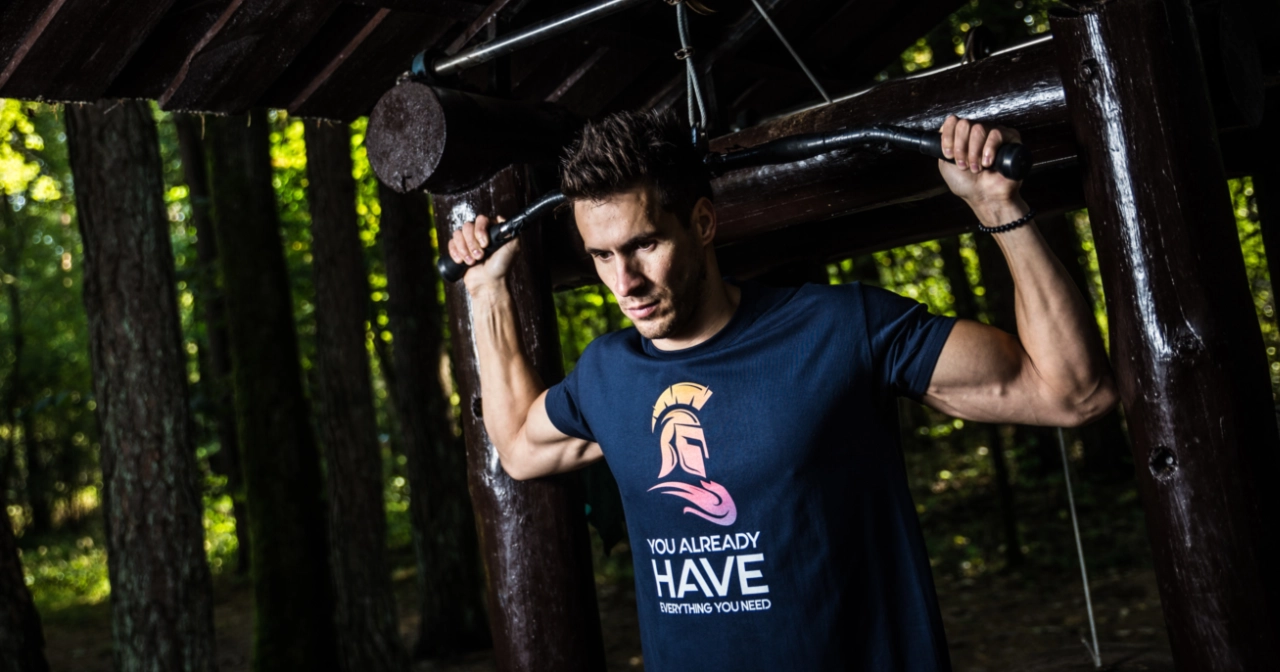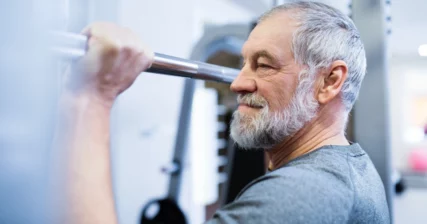Listen on: Apple Podcasts | Spotify
We protect your nervous and skeletal systems.
We provide storage space for carbs and increase your metabolic rate so you won’t get as fat.
We are a great indication of your bone density since the same activities that build us build your bones. Those activities are also like all-natural hormone therapy.
We help you move, give you strength, so you don’t fall as easily, and when you do fall or get in an accident, we tense up, protecting the tissues beneath us.
Oh, and we make you look healthier too.
Unfortunately, most of the medical community talks little about us. They’ve forgotten how essential we are for your health. Maybe they never really knew.
Sadly, many “fitness professionals” don’t even make us a priority in their programming.
We are muscles.
Make us bigger and stronger as long as you can. When you reach old age, hold onto us as long as possible. If you do, you’ll look and feel younger than most people half your age, and according to the research, you’ll live longer as well.
This systematic review and meta-analysis of cohort studies found that muscle-strengthening activities were inversely associated with the risk of CVD, total cancer, diabetes, lung cancer and all-cause mortality independent of aerobic activities among adults aged ≥18 years without severe health conditions.
Muscle-strengthening activities are associated with lower risk and mortality in major non-communicable diseases: a systematic review and meta-analysis of cohort studies
The Health Benefits of Muscle Mass
I’ve written about the health benefits of muscle mass for years. As I’ve reached middle age and seen so many men and women my age getting weaker, gaining body fat, and becoming more sedentary, I’ve become more and more outspoken about building muscle.
My recent bike accident only reinforced my drive to push men and women to build muscle. Here’s why I believe building muscle is the most important thing you can do for your longevity, health, and quality of life.
Building muscle…
Adds to your quality of life savings account
At some point, you’ll likely face a significant injury, illness, other trauma, or age-related muscle loss. At that point, your body will use up a significant portion of your available muscle mass. The more you have when this process begins, the more you’ll be able to lose before really bad things start happening.
The stressed state, such as that associated with sepsis, advanced cancer, and traumatic injury, imposes greater demands for amino acids from muscle protein breakdown than does fasting.
The underappreciated role of muscle in health and disease
Stores carbs, keeping blood sugar levels in check
The more muscle you have, the more carbs you can eat without dealing with insulin resistance, diabetes, or metabolic syndrome.
Muscle-building exercise not only increases the storage space you have for carbs in your diet, it also makes your muscles more sensitive to insulin. You end up secreting less insulin to shuttle carbs, or glucose, into your muscle cells. If you produce less insulin, you can rely on fat more for energy. If you burn more fat during the day, you’ll tap into the fat on your arms, legs, and belly.
alterations in the metabolic function of muscle are central to the development of insulin resistance and ultimately diabetes
The underappreciated role of muscle in health and disease
Protects your joints
Muscles move bones around your joints. When they get weak, or you lose muscle mass, you make your joints more vulnerable to injury and the effects of degeneration.
I’m all about using nutrition and supplements to support your joint health (for example, I use AgilEase from Young Living regularly), but I’d never expect a supplement to solve all my joint aches and pains without building muscle size and strength around that joint.
I believe wholeheartedly that the muscle mass I developed around my neck kept me from experiencing an injury and outcome much worse than what happened when I went headfirst off a bridge on my mountain bike.
Falls are the second-leading cause of death worldwide, next to auto accidents. When you fall, the strength of the muscles surrounding your joints can determine whether your fall leads to a serious injury or not.
Reduces inflammation
Systemic inflammation causes various health problems, including cardiovascular disease, cognitive decline, and joint degeneration. Low muscle mass is correlated with higher inflammation levels. Though the association does not mean having more muscle would lower inflammation, the evidence points in that direction.
Skeletal muscle can actively alter the pro‐ and anti‐inflammatory immune system, regulating innate and adaptive immune responses. Chronic low‐grade systemic inflammation may occur as a direct result of low muscle mass.
Markers of inflammation and their association with muscle strength and mass: A systematic review and meta-analysis
Triggers release of hormones
Hormones like testosterone, IGF-1, and growth hormone help build muscle but interestingly, muscle contraction causes growth hormone secretion too. So, contracting muscles, as you would during an intense training session, secretes one of the major hormones necessary to build more muscle.
Muscular force production also stimulates the release of various types of GH from the pituitary gland (a small gland in the brain).
Hormonal Response to Muscle Contraction
Raises metabolic rate
Muscle costs your body a lot of energy. That’s why it gets rid of muscle you don’t use.
By investing a small amount of time each week, following a well-designed strength and conditioning program, eating a high-protein diet, and getting enough sleep, you tell your body it needs more muscle. As long as you keep giving it the signal, it’ll respond by increasing the size of your muscle cells, thereby increasing your metabolic rate.
If you burn more energy at rest, it’ll be a lot easier to keep your body fat levels in check.
Makes you look healthier
Muscle makes you look healthier because carrying more muscle mass makes you healthier. I’m often surprised by the number of healthcare practitioners, and even some fitness professionals, who don’t look strong and healthy. Many are overweight or obese, and are supposed to be influencing others toward better health.
On the flip side, I’ve noticed more and more fitness professionals marketing themselves with half-naked photos and videos. I get that it might attract some vanity-driven clients, but in my opinion, it misses the mark for which our professions aim.
Supports a strong immune system
I’m writing this in the early fall of 2022, two and a half years after the world got caught up in a media-hyped, highly politicized drama called COVID-19. Since then, companies have made millions selling masks, hand sanitizer, and checkout counter plastic walls. And vaccines.
Home gym equipment sales went through the roof, too, but it wasn’t because people got an itch to start exercising. It was because narrow-minded public health policy makers decided that gyms weren’t essential. The gym members that were already committed to exercise needed to keep exercising, so they bought equipment they could use at home. Meanwhile, those who weren’t already in the habit of exercising and eating well became even less healthy than they were before the whole drama began.
Even today, you’ll see a large part of the population walking around stores while wearing masks, even though it’s clear that COVID is more of a coldvid.
With all the attention placed upon supporting a strong immune system, building muscle gets almost no airtime. And yet, numerous studies show that your level of muscle mass is a large determiner of your immune system strength.
If you’re at all concerned about getting sick by a future virus or bacteria, you should spend less time rubbing on hand sanitizer and more time resistance training.
Protects your heart
I had to wrap up the health benefits of muscle mass with this one. We’ve been sold the idea that you need to do aerobic or endurance exercise for a healthy heart. That’s not true.
In fact, excessive aerobic exercise can be detrimental to our heart health. It can also cause significant muscle loss, lower testosterone, and compromise joint health.
Muscle mass is cardioprotective. A 10-year study followed men and women without any sign of cardiovascular disease at the beginning. Not surprisingly, men in general were more likely to develop cardiovascular disease. What stood out, though, was that those with the highest levels of muscle mass were the least likely to develop cardiovascular disease. They were 81% less likely to have a heart attack or stroke.
If you’re serious about your health, you’ll start, and never stop, strength training.
Why Most Fitness Programs Miss the Mark
There’s an ongoing saying in the fitness world that the best program to choose is the one that you will follow. However, as humans, we tend to do that which requires the least amount of effort or change in our lifestyles.
If we buy into that saying, we will choose a program that does little to build muscle and ensure the best quality of life for the future.
Sadly, most of the fitness programs you’ll see advertised on social media or on TV sell programs that tell you what you want to hear: work out from home. Get it done in 15 minutes. Use equipment you have on hand. Those kinds of messages are a great way for a company to make a lot of money but not a solution for your long-term health and fitness.
If you don’t have a full home gym set up, the best thing you can do is to join a gym. At a minimum, it should have a squat rack, bench, rack of dumbbells, plates, and barbells. Cable machines her also really useful.
The next step is to follow a program focused on building muscle first. Too many fitness professionals today get caught up in “functional training,” and end up using considerable time having clients do balance exercises and stability movements that do little to build muscle. But if you build muscle first, you will have the strength to balance and create stability throughout your body.
Follow a solid strength training program three to four days per week and if you so choose, add on a group fitness class, yoga, or other conditioning or mobility-based workout. Just don’t do those in place of an intense strength training program.
What to Expect from a Muscle-Building Resistance Training Program
When you get started with a good strength training program, you should see a significant increase in strength from week to week for your first 12 to 16 weeks.
During that time, your coordination improves as your body learns to use more of the muscle you already have. After that, the strength increases decreases because your body has to build more muscle to continue building more strength.
Oftentimes this is when people start looking for something else to do. They believe that they’re not getting results anymore. But this is where the health benefits I described above really come into play.
After about four months, as long as you’re eating well, sticking with your program, and getting enough sleep, you will start to see incremental increases in muscle mass. This is the case whether you’re in your 20s or 80s. Of course, if you’re older, the amount of muscle you can build could be limited, but you’ll still be able to build muscle and improve your health nonetheless.
Six More Months to Live
I’ll wrap this up with something I’ve thought a lot about since I broke my neck.
At the end of our lives, many of us will wish we had more time to live. But while we were alive, we neglected the things we could have done to put more time on the clock.
The doctors told me it would take a year to fully recover from my broken neck and spinal cord injury. At that moment, I committed to doing everything possible to be fully recovered in six months.
I knew that if my recovery took only six months instead of 12, I’d be able to fully live my life for six more months than the doctors said I would. That means more skiing, mountain biking, working in the woods, being more active in building our businesses, roughhousing with our grandson, and doing all that a husband should do.
For most of human history, we’ve sought a “fountain of youth” that adds more days to our lives. Modern medicine has added years of life, but modern lifestyles have reduced our quality of life. The best thing you can do to make the most of your years is to build and maintain muscle.
Be strong. Live long.
Photo by Frame Kings on Unsplash



